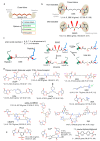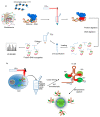Interfaces with Structure Dynamics of the Workhorses from Cells Revealed through Cross-Linking Mass Spectrometry (CLMS)
- PMID: 33806612
- PMCID: PMC8001575
- DOI: 10.3390/biom11030382
Interfaces with Structure Dynamics of the Workhorses from Cells Revealed through Cross-Linking Mass Spectrometry (CLMS)
Abstract
The fundamentals of how protein-protein/RNA/DNA interactions influence the structures and functions of the workhorses from the cells have been well documented in the 20th century. A diverse set of methods exist to determine such interactions between different components, particularly, the mass spectrometry (MS) methods, with its advanced instrumentation, has become a significant approach to analyze a diverse range of biomolecules, as well as bring insights to their biomolecular processes. This review highlights the principal role of chemistry in MS-based structural proteomics approaches, with a particular focus on the chemical cross-linking of protein-protein/DNA/RNA complexes. In addition, we discuss different methods to prepare the cross-linked samples for MS analysis and tools to identify cross-linked peptides. Cross-linking mass spectrometry (CLMS) holds promise to identify interaction sites in larger and more complex biological systems. The typical CLMS workflow allows for the measurement of the proximity in three-dimensional space of amino acids, identifying proteins in direct contact with DNA or RNA, and it provides information on the folds of proteins as well as their topology in the complexes. Principal CLMS applications, its notable successes, as well as common pipelines that bridge proteomics, molecular biology, structural systems biology, and interactomics are outlined.
Keywords: CLMS; chemical cross-linkers; cross-linking mass spectrometry; protein–DNA; protein–RNA interactions; protein–protein; proteomics; structural biology.
Conflict of interest statement
The authors declare no conflict of interest.
Figures






References
Publication types
MeSH terms
Substances
Grants and funding
LinkOut - more resources
Full Text Sources
Other Literature Sources

